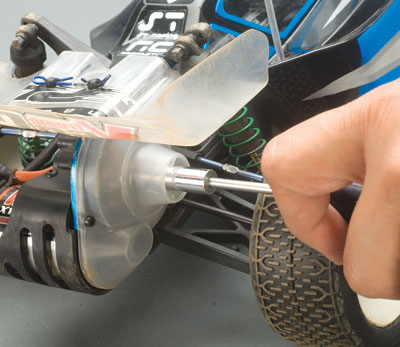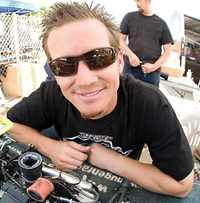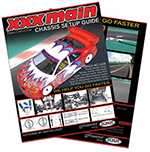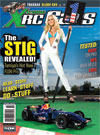|
| Traction,
grip, bite—call it what you want, it is the only thing
bonding your tires to the racing surface, and it
determines everything on the racetrack. The two most
popular components of traction are forward grip and side
grip. Forward grip defines how much traction you have when
accelerating in a forward direction, and helps to
determine things such as how quickly you can accelerate
out of a turn, or if you'll be able to clear a huge triple
with a short run-up. Side grip is the amount of traction
available when a tire experiences side loading, such as
through a turn.
Texte en Français |
|
Issue
168 (November 2009) - Words: Jeff Eveleigh
It becomes very difficult to discuss
forward grip on its own because, other than with a starting grid, it
is almost always a component of corner exit. That being said, we're
going to break down and explain how to adjust for forward grip within
your chassis. Much of this article will tackle physics and theories,
but remember that there are so many factors to chassis setup that no
amount of theory beats good old track time So, learn how your vehicle
is supposed to react to certain changes, and then go try some of them
yourself to see how they work with your setup, driving style and track
conditions.
TIRES
 Tires
should be the largest single factor when it comes to any traction
consideration. This holds true for forward grip as well. Given that
tires are so important, we snagged ourselves an expert to interrogate:
pro driver Scott Hughes of Pro-Line fame sat down with us for a bit
and chatted rubber, tread, traction and gazebos! Tires
should be the largest single factor when it comes to any traction
consideration. This holds true for forward grip as well. Given that
tires are so important, we snagged ourselves an expert to interrogate:
pro driver Scott Hughes of Pro-Line fame sat down with us for a bit
and chatted rubber, tread, traction and gazebos!
When choosing a tire to maximize
forward grip, you only really need to concentrate on the tread design.
Different tire compounds don't play a huge role in determining forward
grip and are chosen based on specific track, dirt, and wear conditions
(we'll be doing an article on tire compounds in an upcoming issue).
Tread design is the master of accelerating hard in a straight line and
Hughes gave us the goods on why the shapes are the way they are on
many tires. When looking to maximize forward grip, you want a tread
design that offers horizontal bars from left to right, such as those
on a Pro-Line Bow-Tie. Longer cross bar designs act almost like a
paddle, scooping the dirt and providing unmatched forward grip.


Another major factor of tread design that
affects forward grip is the density of the spikes in the center of the
tire. Tires such as Pro-Line's Revolver and Caliber pay more attention
to the center treads. As the tire expands under heavy acceleration,
the only contact patch is that of the center spikes. More center
spikes offer more forward grip, and longer tire wear when your finger
is heavy on the throttle. Also keep in mind that any tire tread
choices that increase forward grip will also greatly increase your
vehicle's braking ability in the forward direction.
As a final note on tires Hughes gave us
a list of the most typical track surfaces and the top two Pro-Line
tires, starting with the one that offers the most forward-grip.
Remember that this stuff is never carved in stone, but can be used as
a strong guideline to start.
Surface Type
Hard, packed and wet - Caliber, hole shot
Blue groove and smooth - Revolver, bow-tie
Loose and loamy - Bow-tie, caliber
 TRACTION
CONTROL TRACTION
CONTROL
We've talked a lot about
maximizing the forward grip of your car, but what happens when
the power plant within your vehicle overcomes the
weight-transfer physics of your chassis or the ability of your
tires to make grip? Now we have to make changes to harness the
extra power to prevent wheel spin and again maximize the
available forward grip. This can be done easily through your
slipper clutch if your vehicle has one. A slipper clutch is a
relatively simple traction control system that allows your
transmission to absorb excess power from going to your wheels
and creating spin. To set your slipper, place your car on one
of the lower traction areas of the racing surface and hammer
the throttle. If your tires spin, then loosen your slipper
slightly. Keep doing this until you can grab a handful of
throttle and launch from your starting position without
fishtailing everywhere. This is your perfect starting point;
now you can make minor changes to fine-tune your slipper for
the rest of the track.
|
TIRE INSERTS
 The
inserts used within your tires will not affect handling as drastically
as tire or tread design, but they still play a role in forward grip.
When it comes to off-road racing, a softer insert will give you better
side bite, while a firmer insert will increase forward grip. A firmer
insert helps to maintain tire shape integrity more closely under heavy
acceleration, allowing the tires design to do its job. A softer insert
allows more pin flex, which would reduce contact in a straight line
and reduce forward-grip slightly. The opposite holds true for on-road
inserts. A firmer insert will help prevent your tire from rolling over
while side-loaded—increasing side-grip, while a softer insert will
increase forward-grip. The
inserts used within your tires will not affect handling as drastically
as tire or tread design, but they still play a role in forward grip.
When it comes to off-road racing, a softer insert will give you better
side bite, while a firmer insert will increase forward grip. A firmer
insert helps to maintain tire shape integrity more closely under heavy
acceleration, allowing the tires design to do its job. A softer insert
allows more pin flex, which would reduce contact in a straight line
and reduce forward-grip slightly. The opposite holds true for on-road
inserts. A firmer insert will help prevent your tire from rolling over
while side-loaded—increasing side-grip, while a softer insert will
increase forward-grip.
REAR TOE
 Adjusting
rear toe angles is one of the quickest, easiest and most reliable
forms of increasing rear traction almost everywhere on the racetrack.
If you need a bump in forward grip, then try adding 0.5 to 1 degree of
toe-in at the rear of your car. You'll be able to accelerate harder
out of a turn with the increased rear traction (but keep in mind that
increased rear toe-in will reduce your steering through pretty much
all phases of a corner). Adjusting
rear toe angles is one of the quickest, easiest and most reliable
forms of increasing rear traction almost everywhere on the racetrack.
If you need a bump in forward grip, then try adding 0.5 to 1 degree of
toe-in at the rear of your car. You'll be able to accelerate harder
out of a turn with the increased rear traction (but keep in mind that
increased rear toe-in will reduce your steering through pretty much
all phases of a corner).
WEIGHT TRANSFER AND CHASSIS
CHANGES
 When
it comes to weight transfer and forward traction, two of the most
common adjustments affecting front-to-back movement are droop and
anti-squat. When dealing with 4WD vehicles, the trick to increasing
forward-grip is to try and balance the power amongst all four driven
wheels. While under acceleration, your chassis wants to transfer
weight to the rear of the car, so adjustments need to be made to help
keep weight over the front-driven wheels to fully utilize their
traction-providing capabilities (and fully appreciate the advantages
of 4WD). When too much weight is transferred to the rear of the car
under acceleration, the front-driven tires can unload and spin,
reducing their pull in the forward direction. Reducing front droop or
increasing rear anti-squat will help to prevent so much weight
transfer to the rear of your car maximizing forward-grip. When
it comes to weight transfer and forward traction, two of the most
common adjustments affecting front-to-back movement are droop and
anti-squat. When dealing with 4WD vehicles, the trick to increasing
forward-grip is to try and balance the power amongst all four driven
wheels. While under acceleration, your chassis wants to transfer
weight to the rear of the car, so adjustments need to be made to help
keep weight over the front-driven wheels to fully utilize their
traction-providing capabilities (and fully appreciate the advantages
of 4WD). When too much weight is transferred to the rear of the car
under acceleration, the front-driven tires can unload and spin,
reducing their pull in the forward direction. Reducing front droop or
increasing rear anti-squat will help to prevent so much weight
transfer to the rear of your car maximizing forward-grip.
 The
opposite holds true for 2WD cars where the front wheels aren't driven.
To increase forward traction with this drive setup, you want to
transfer chassis weight over the rear tires to reduce wheel spin and
maximize forward grip. This is done by increasing the amount of front
droop, allowing the front end to rise up further during acceleration
and transfer more weight over the rear end. You can also increase
forward-grip in a 2WD vehicle by reducing anti-squat allowing the rear
suspension to settle more once you tag the throttle. The
opposite holds true for 2WD cars where the front wheels aren't driven.
To increase forward traction with this drive setup, you want to
transfer chassis weight over the rear tires to reduce wheel spin and
maximize forward grip. This is done by increasing the amount of front
droop, allowing the front end to rise up further during acceleration
and transfer more weight over the rear end. You can also increase
forward-grip in a 2WD vehicle by reducing anti-squat allowing the rear
suspension to settle more once you tag the throttle.
CAMBER
 When
it comes to camber and forward grip, it all really comes down to tire
patch and surface area against the racing plane. The closer your camber
angles are to 0 degrees, the more forward grip your setup will offer.
Reducing camber to increase traction in a straight line isn't always the
best first move, since you will almost definitely lose grip throughout
the turn. Since camber is such a great tool for adjusting for side-grip,
there is usually another setup change that can be made to increase
forward grip without drastically affecting other aspects of handling. When
it comes to camber and forward grip, it all really comes down to tire
patch and surface area against the racing plane. The closer your camber
angles are to 0 degrees, the more forward grip your setup will offer.
Reducing camber to increase traction in a straight line isn't always the
best first move, since you will almost definitely lose grip throughout
the turn. Since camber is such a great tool for adjusting for side-grip,
there is usually another setup change that can be made to increase
forward grip without drastically affecting other aspects of handling.
SCOTT HUGHES / OFFROAD
FORWARD TRACTION
 Scott
Hughes needs no introduction, but we'll do it anyway. Pro-Line's front
man is also one of nitro off-road's fastest drivers and setup guys. With
multiple Worlds finishes and countless National podiums, this guy can
win on any given day at the racetrack. After hitting the track with his
Mugen MBX-6, here's what he uses to increase his buggy's forward grip. Scott
Hughes needs no introduction, but we'll do it anyway. Pro-Line's front
man is also one of nitro off-road's fastest drivers and setup guys. With
multiple Worlds finishes and countless National podiums, this guy can
win on any given day at the racetrack. After hitting the track with his
Mugen MBX-6, here's what he uses to increase his buggy's forward grip.
1st - Tires - The best tire
for the track is the most important component for success. Refer to the
tire section above for specific tips on tire choice and how they relate
to forward grip.
2nd - Rear Toe - Increase
rear toe-in for more forward grip, but remember that you'll lose some
steering.
3rd - Anti-Squat - Reduce
anti-squat to put more weight on rear end under acceleration. (Editor's
note: this contradicts some of our story, but with suspension setup
issues, nothing is as cut and dry as it seems. Hughes explained that
less anti-squat will increase forward grip when off-road tracks are
loose or blown out. The opposite is true for high-bite tracks where more
anti-squat will increase forward grip. Less anti-squat on high-bite
tracks will transfer too much weight to the rear and cause it to wash
out or lose traction. This is why 4WD touring cars always increase
anti-squat to get more forward grip since all on-road tracks are
relatively high-bite compared with off-road racing).
4th - Diff Oils - Lighter
diff oil in the rear and thicker oil in the front and center
differential will increase forward-grip by helping the front tires to
pull the car forward under acceleration.
MARTIN CRISP / ONROAD
FORWARD TRACTION
 Martin
Crisp is the author of the "XXX Main Racing Touring Chassis Setup
Guide" and he is known as a setup god! With multiple A-main
finishes at National events as well as Worlds qualifications, Martin
knows how to translate his setup ideas into results on the racetrack.
Here is the list of changes Martin makes when he wants to increase
forward-grip on his Tamiya Touring Car. Martin
Crisp is the author of the "XXX Main Racing Touring Chassis Setup
Guide" and he is known as a setup god! With multiple A-main
finishes at National events as well as Worlds qualifications, Martin
knows how to translate his setup ideas into results on the racetrack.
Here is the list of changes Martin makes when he wants to increase
forward-grip on his Tamiya Touring Car.
 1st
- Tires - Softer tires offer more forward grip and less side bite. (And
softer inserts also offer more forward grip in an on-road car). 1st
- Tires - Softer tires offer more forward grip and less side bite. (And
softer inserts also offer more forward grip in an on-road car).
2nd - Droop - Reducing front
droop will help keep weight over the front-driven tires, increasing
forward grip.
3rd - Diff Pulley Height -
Raising the rear diff and lowering the front diff will cause more weight
to transfer forward under acceleration, causing front tires to offer
more grip and thus more forward traction.
4th - Camber - Reducing
negative camber to get more contact patch will increase forward grip.
You may give up corner speed but you can get that back with other setup
changes.
CLOSING
Any form of chassis or tire
setup changes can become highly complex regardless of what class you are
racing. Remember that one change almost always affects another area of
your chassis, so try to match symptoms and find solutions that group
issues together. We can theorize all day about what screw to turn or
what tires to mount, but the final result should always come from what
works best on the race course.
Source:


|
 Tires
should be the largest single factor when it comes to any traction
consideration. This holds true for forward grip as well. Given that
tires are so important, we snagged ourselves an expert to interrogate:
pro driver Scott Hughes of Pro-Line fame sat down with us for a bit
and chatted rubber, tread, traction and gazebos!
Tires
should be the largest single factor when it comes to any traction
consideration. This holds true for forward grip as well. Given that
tires are so important, we snagged ourselves an expert to interrogate:
pro driver Scott Hughes of Pro-Line fame sat down with us for a bit
and chatted rubber, tread, traction and gazebos!

 TRACTION
CONTROL
TRACTION
CONTROL
 The
inserts used within your tires will not affect handling as drastically
as tire or tread design, but they still play a role in forward grip.
When it comes to off-road racing, a softer insert will give you better
side bite, while a firmer insert will increase forward grip. A firmer
insert helps to maintain tire shape integrity more closely under heavy
acceleration, allowing the tires design to do its job. A softer insert
allows more pin flex, which would reduce contact in a straight line
and reduce forward-grip slightly. The opposite holds true for on-road
inserts. A firmer insert will help prevent your tire from rolling over
while side-loaded—increasing side-grip, while a softer insert will
increase forward-grip.
The
inserts used within your tires will not affect handling as drastically
as tire or tread design, but they still play a role in forward grip.
When it comes to off-road racing, a softer insert will give you better
side bite, while a firmer insert will increase forward grip. A firmer
insert helps to maintain tire shape integrity more closely under heavy
acceleration, allowing the tires design to do its job. A softer insert
allows more pin flex, which would reduce contact in a straight line
and reduce forward-grip slightly. The opposite holds true for on-road
inserts. A firmer insert will help prevent your tire from rolling over
while side-loaded—increasing side-grip, while a softer insert will
increase forward-grip.
 Adjusting
rear toe angles is one of the quickest, easiest and most reliable
forms of increasing rear traction almost everywhere on the racetrack.
If you need a bump in forward grip, then try adding 0.5 to 1 degree of
toe-in at the rear of your car. You'll be able to accelerate harder
out of a turn with the increased rear traction (but keep in mind that
increased rear toe-in will reduce your steering through pretty much
all phases of a corner).
Adjusting
rear toe angles is one of the quickest, easiest and most reliable
forms of increasing rear traction almost everywhere on the racetrack.
If you need a bump in forward grip, then try adding 0.5 to 1 degree of
toe-in at the rear of your car. You'll be able to accelerate harder
out of a turn with the increased rear traction (but keep in mind that
increased rear toe-in will reduce your steering through pretty much
all phases of a corner). When
it comes to weight transfer and forward traction, two of the most
common adjustments affecting front-to-back movement are droop and
anti-squat. When dealing with 4WD vehicles, the trick to increasing
forward-grip is to try and balance the power amongst all four driven
wheels. While under acceleration, your chassis wants to transfer
weight to the rear of the car, so adjustments need to be made to help
keep weight over the front-driven wheels to fully utilize their
traction-providing capabilities (and fully appreciate the advantages
of 4WD). When too much weight is transferred to the rear of the car
under acceleration, the front-driven tires can unload and spin,
reducing their pull in the forward direction. Reducing front droop or
increasing rear anti-squat will help to prevent so much weight
transfer to the rear of your car maximizing forward-grip.
When
it comes to weight transfer and forward traction, two of the most
common adjustments affecting front-to-back movement are droop and
anti-squat. When dealing with 4WD vehicles, the trick to increasing
forward-grip is to try and balance the power amongst all four driven
wheels. While under acceleration, your chassis wants to transfer
weight to the rear of the car, so adjustments need to be made to help
keep weight over the front-driven wheels to fully utilize their
traction-providing capabilities (and fully appreciate the advantages
of 4WD). When too much weight is transferred to the rear of the car
under acceleration, the front-driven tires can unload and spin,
reducing their pull in the forward direction. Reducing front droop or
increasing rear anti-squat will help to prevent so much weight
transfer to the rear of your car maximizing forward-grip.
 The
opposite holds true for 2WD cars where the front wheels aren't driven.
To increase forward traction with this drive setup, you want to
transfer chassis weight over the rear tires to reduce wheel spin and
maximize forward grip. This is done by increasing the amount of front
droop, allowing the front end to rise up further during acceleration
and transfer more weight over the rear end. You can also increase
forward-grip in a 2WD vehicle by reducing anti-squat allowing the rear
suspension to settle more once you tag the throttle.
The
opposite holds true for 2WD cars where the front wheels aren't driven.
To increase forward traction with this drive setup, you want to
transfer chassis weight over the rear tires to reduce wheel spin and
maximize forward grip. This is done by increasing the amount of front
droop, allowing the front end to rise up further during acceleration
and transfer more weight over the rear end. You can also increase
forward-grip in a 2WD vehicle by reducing anti-squat allowing the rear
suspension to settle more once you tag the throttle.
 When
it comes to camber and forward grip, it all really comes down to tire
patch and surface area against the racing plane. The closer your camber
angles are to 0 degrees, the more forward grip your setup will offer.
Reducing camber to increase traction in a straight line isn't always the
best first move, since you will almost definitely lose grip throughout
the turn. Since camber is such a great tool for adjusting for side-grip,
there is usually another setup change that can be made to increase
forward grip without drastically affecting other aspects of handling.
When
it comes to camber and forward grip, it all really comes down to tire
patch and surface area against the racing plane. The closer your camber
angles are to 0 degrees, the more forward grip your setup will offer.
Reducing camber to increase traction in a straight line isn't always the
best first move, since you will almost definitely lose grip throughout
the turn. Since camber is such a great tool for adjusting for side-grip,
there is usually another setup change that can be made to increase
forward grip without drastically affecting other aspects of handling.
 Scott
Hughes needs no introduction, but we'll do it anyway. Pro-Line's front
man is also one of nitro off-road's fastest drivers and setup guys. With
multiple Worlds finishes and countless National podiums, this guy can
win on any given day at the racetrack. After hitting the track with his
Mugen MBX-6, here's what he uses to increase his buggy's forward grip.
Scott
Hughes needs no introduction, but we'll do it anyway. Pro-Line's front
man is also one of nitro off-road's fastest drivers and setup guys. With
multiple Worlds finishes and countless National podiums, this guy can
win on any given day at the racetrack. After hitting the track with his
Mugen MBX-6, here's what he uses to increase his buggy's forward grip. Martin
Crisp is the author of the "XXX Main Racing Touring Chassis Setup
Guide" and he is known as a setup god! With multiple A-main
finishes at National events as well as Worlds qualifications, Martin
knows how to translate his setup ideas into results on the racetrack.
Here is the list of changes Martin makes when he wants to increase
forward-grip on his Tamiya Touring Car.
Martin
Crisp is the author of the "XXX Main Racing Touring Chassis Setup
Guide" and he is known as a setup god! With multiple A-main
finishes at National events as well as Worlds qualifications, Martin
knows how to translate his setup ideas into results on the racetrack.
Here is the list of changes Martin makes when he wants to increase
forward-grip on his Tamiya Touring Car. 1st
- Tires - Softer tires offer more forward grip and less side bite. (And
softer inserts also offer more forward grip in an on-road car).
1st
- Tires - Softer tires offer more forward grip and less side bite. (And
softer inserts also offer more forward grip in an on-road car).
